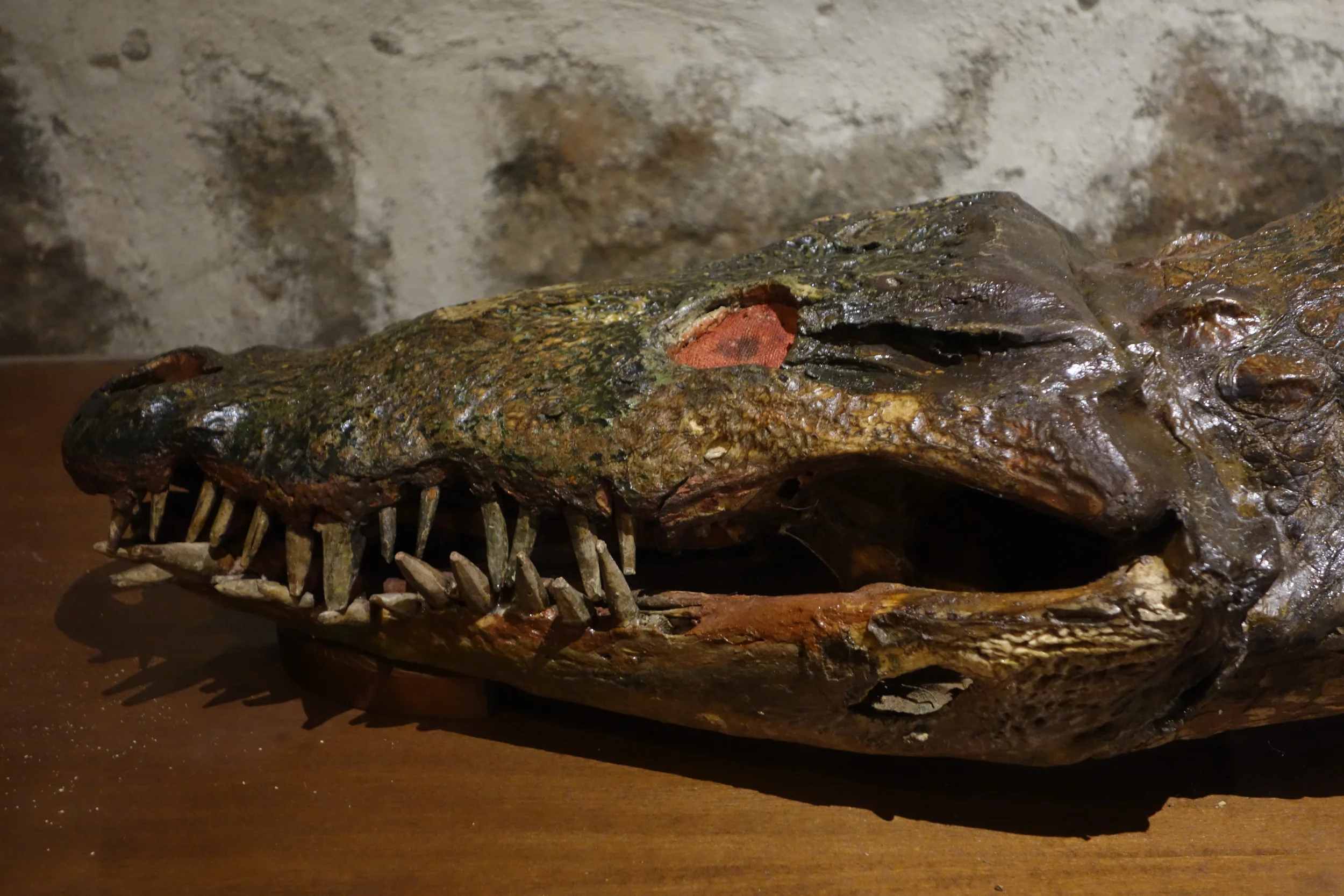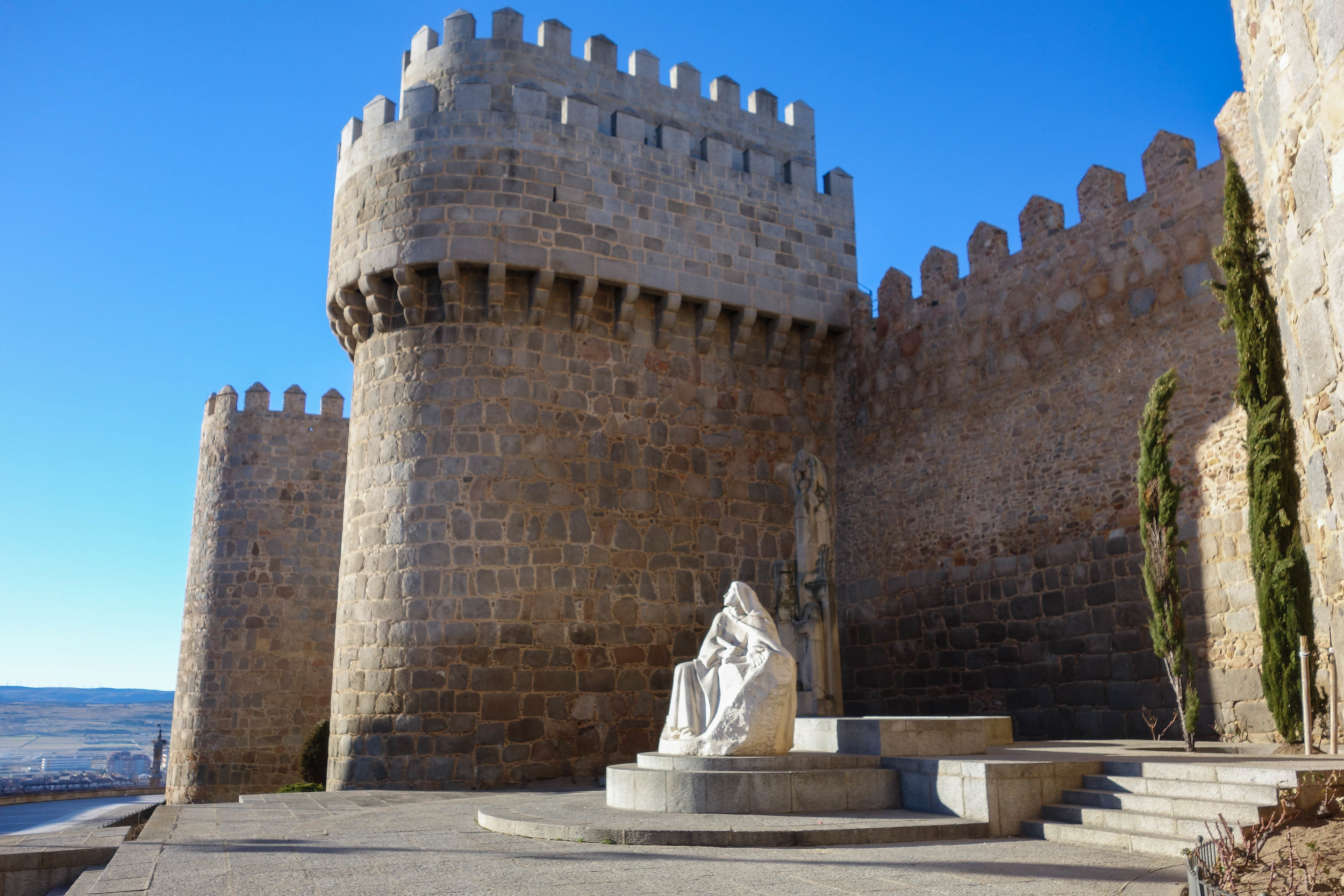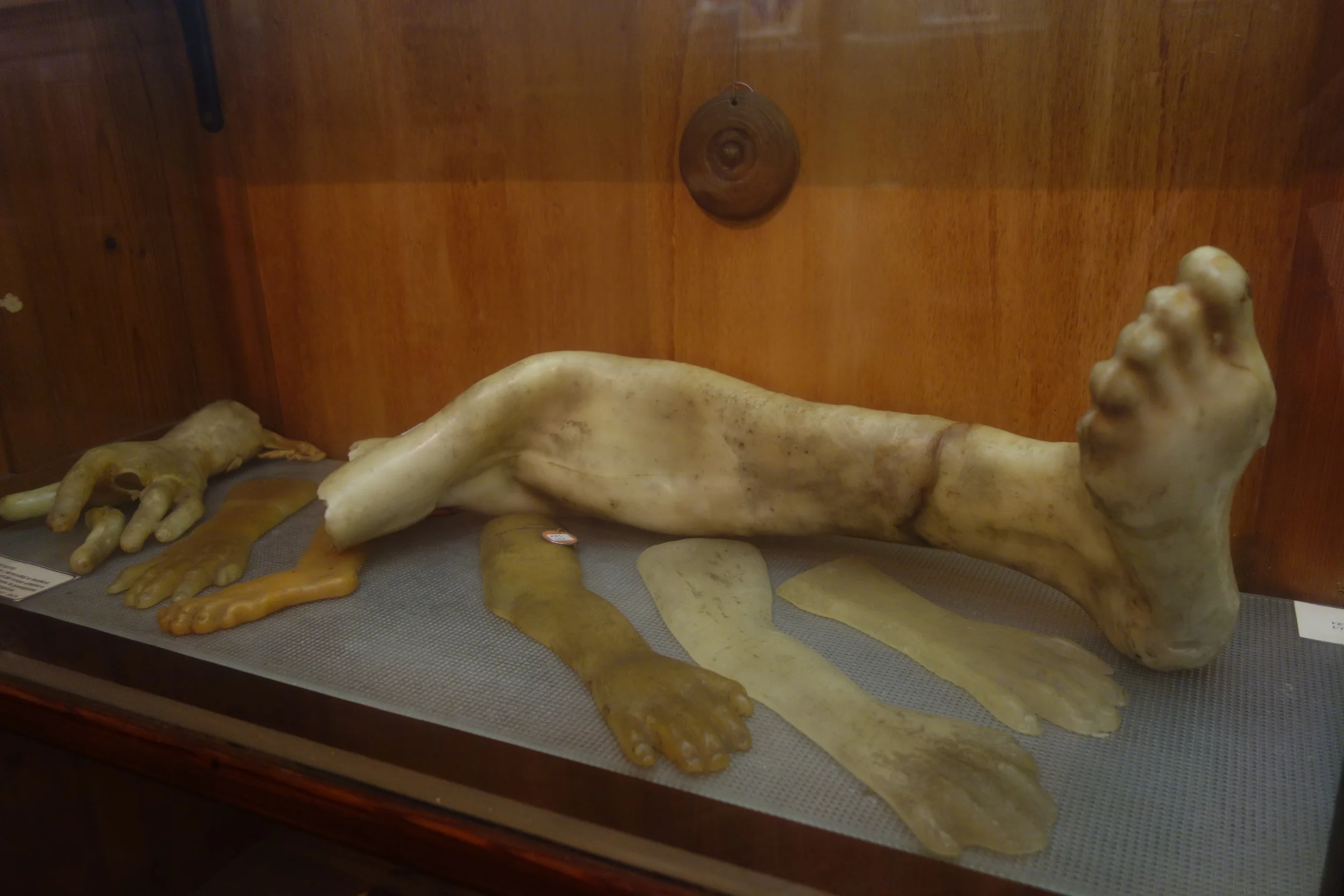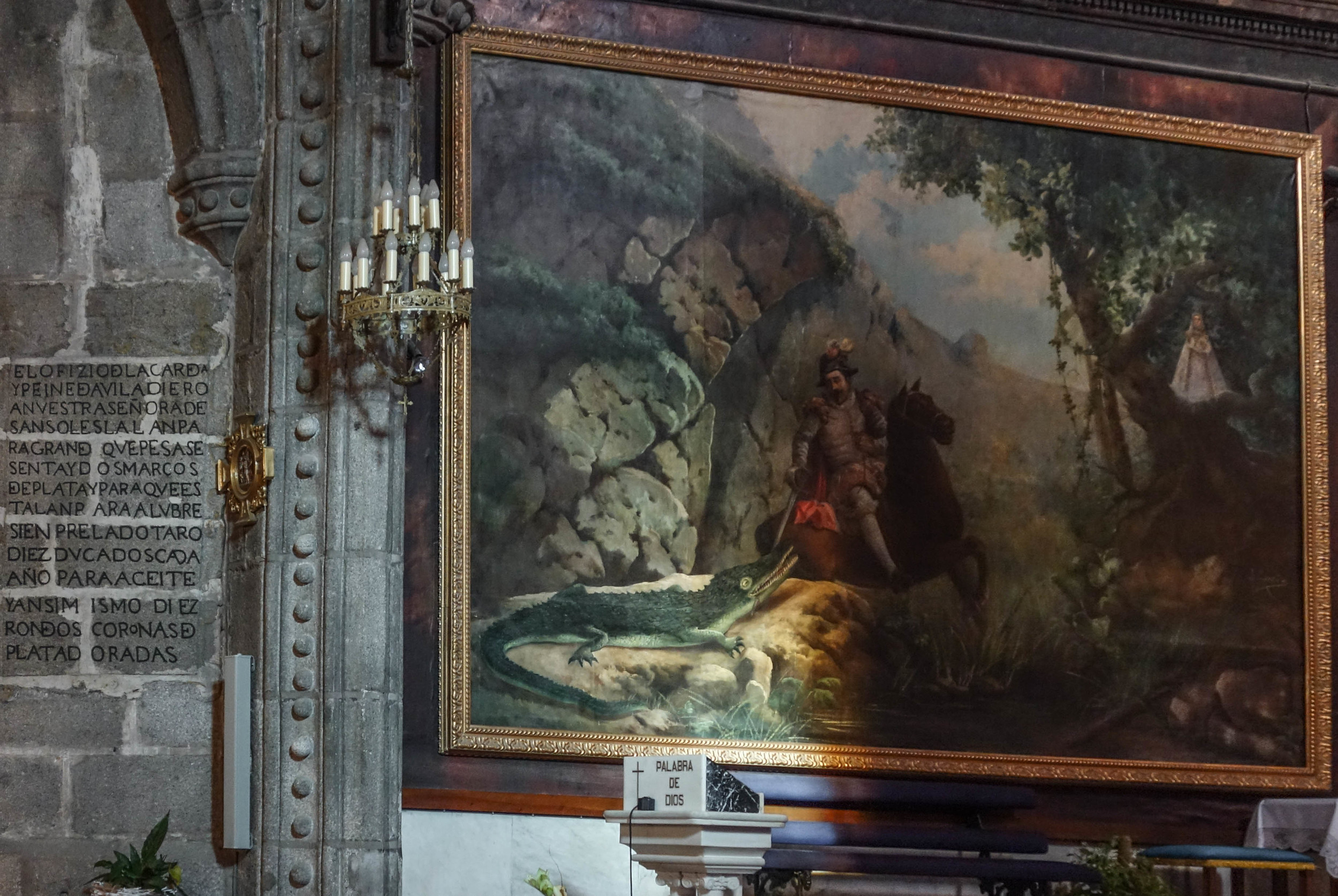Crocodile Prayers
Originally published on Killing the Buddha.
I visited the church of San Ginés on safari like a fool. No one safaris in Madrid, and it’s frowned upon to safari inside a Catholic church. I went there to hunt a crocodile. Specifically, a taxidermied one rumored to be on display.
I milled around the church single-mindedly. The coffin of a saintly ten-year-old was not a crocodile. A life-sized weeping Madonna was not a crocodile. Pilgrims circled around a miracle-working statue of St. Jude. No matter; not a crocodile. When I exhausted every alcove, I decided to interact with the caretaker, armed with some Spanish I picked up from Sesame Street.
“Dónde está el… el…”
I held my hands flat in front of me—palms together but slightly cupped, and made two silent claps with my wrists touching.
The caretaker pointed to the chapel of Our Lady, a void of a room interrupted only by the light reflecting off an icon of the Virgin. A sign prohibited tourists in several languages. I considered thanking him and bailing, but that would confirm I was a godless crocodile hunter and curiosity would gnaw at me later. I couldn’t take his word, or rather his gesture, for it. I had to know.
If you’ve ever been a Good Catholic Girl, there are certain things you cannot bring yourself to do; violating the chapel of Our Lady in the name of hunting crocodiles was one of them. I compromised. Or that’s how I justified the worst Hail Mary I’ve ever said. I said it as my eyes scanned the room looking for a crocodile that wasn’t there. I pictured God receiving that prayer like a fax from an unknown number. He would tell an angel to file it under “crocodile,” and they would laugh because that was His euphemism for the trashcan.
On my way out, I saw a sign for a guided tour of the church’s art collection the next morning. Surely this would include their famous piece of taxidermy and this time I would avoid the international hand sign for crocodile. Back at my hotel I learned the stunningly obvious word cocodrilo.
Thanks to this new vocabulary, I understood the docent clearly when he said there was no cocodrilo (as we say in Madrid). The “chapel lizard” of San Ginés was an urban legend. The caretaker was having a little fun with another clueless tourist. There might have been a crocodile at one point, but people seem to think a former priest threw it away. It was rumored he was tired of people stopping in for Godzilla, but not so much for God.
In my defense, I hadn’t pulled the idea of a church crocodile from an urban legend. In Medina de Rioseco, Spain, the flayed hide of a crocodile is draped over a cornice. Taxidermy crocodiles climb the walls in St. Bertand-de-Comminges, France and Viso del Marqués, Spain. A fifteen-footer sits in a church just outside of Verona. Crocodiles are chained to the ceilings in Seville and Grazie.
Some, like the one in Seville, were exotic souvenirs, displayed in churches to allow the congregation a glimpse at one of God’s more impressive creations. Others are more symbolic. They’re like saints holding props meant to jog your memory about their lives (or more frequently, their gruesome deaths). They’re simple but memorable visual aides designed to edify illiterate masses, whether those masses are medieval peasants or modern women from Los Angeles trying to communicate via hand-puppet.
In these Catholic pictograms, crocodiles are dragons and dragons are evil incarnate. The poet Edward Young even pointed out that their breath looked like smoke when it hit cool water, making them ideal stand-ins for the biblical fire-breather Leviathan, a reptile whose “teeth are terrible round about.”
Anyone can kill an animal, but it takes more than bravery and weaponry to vanquish evil. For that, you need God. So we hear stories about dragon-slaying saints like George, Margaret of Antioch, and Theodore of Amasea who tops a column with a crocodilesque dragon in St. Mark’s Square. The flayed, stuffed, chained, and otherwise subjugated crocs sprinkled around Europe are the church’s metaphorical evil-hunting trophies.
The stories of these supernatural crocodile-slaying saints are meant to illustrate God’s power—but try explaining that to a crocodile. Especially the ones who had their lives cut short by Catholic missionaries abroad living out their Saint George fantasies. They undoubtedly would’ve preferred to die of old age in their swamps but now their carcasses are strung up in church. They never asked to be anyone’s symbol of anything, and yet, here they are. Or, in the case of San Ginés, here they aren’t.
***
The day after my failed safari in Madrid, I took a train to Ávila to see, among other things, a church rumored to have its own crocodile. But on a Sunday in early January the little medieval city was hung over from New Year’s and seemed surprised to have a visitor. The bus that drove tourists outside the city walls was canceled. So I walked.
I walked through the city, outside the medieval walls, past the place where the modern apartment buildings stopped, past where the pavement turned to dirt. I walked past where the grazing sheep were allowed to roam until I got to the church.
I imagined the crocodile, if it existed, would be in the church’s famous collection of ex voto, a tradition that sounds fairly pedestrian on paper. If you pray for something and God helps you, you get Him a nice thank-you gift. Most ex voto are humble metal charms that depict the thing you prayed for. Body parts like eyes, legs, and breasts are common, but in Mexico City I even saw a desktop computer.
If God helps you in extraordinary ways and you have the means, you can let your imagination run wild when deciding on an ex voto. In Rome I saw a life-sized leg made of flesh-colored wax. There are mosaics made of seashells in Barcelona and miniature jeweled crowns made for statues of Mary in Prague.
In the handful of churches that still keep extensive ex voto collections, it’s easy to see how the 16th century curiosity cabinet grew out of the church. While the holy bone relics of the saints might have become pieces of Egyptian mummies or medical specimens, other pieces just seemed to linger on in their new secular context. In the very first image of one of these wunderkammers, you’ll find a stuffed crocodile.
In Ávila’s ex voto room there were baby clothes, sports trophies, and an entire rack of wedding dresses. It looked like a Goodwill. Concealing my disappointment, I gave up on my safari and went in the church. But there, in the back, I found one more ex voto too large for that strange little room—a real stuffed crocodile.
A plaque and a painting on the left side of the altar filled in the details. While traveling in newly discovered America, a Spanish man was nearly killed by the crocodile but thanks to an intervention by the Virgin Mary, he was able to slay the beast. In thanksgiving he stuffed it and turned it into an ex voto. Though taxidermy was still in its infancy (which may explain why the crocodile’s back legs appear to be on sideways) a crocodile was a relatively easy animal to preserve, because its hide is so tough. The oldest extant piece of taxidermy is a crocodile, claimed by a church in Lombardy.
Satisfied, I set out to make my way back into the city before sunset. Outside, the cathedral of Ávila was a tiny spike on the horizon. It was a successful safari after all. I discovered the crocodile. To be fair, he was exactly where he had been for hundreds of years, but a safari is always about discovering what’s already there.
I started out towards the city, feet tired, church shoes caked in mud. I had a nagging thought about the church in Madrid. What if my prayer didn’t go unheard after all? Maybe God looked at yet another crocodile prayer coming in from San Ginés and said to His angel, “You know what, let’s give this one a crocodile. But go ahead and cancel Ávila’s bus service.”
I contemplated sending a crocodile to Our Lady at San Ginés in gratitude.






